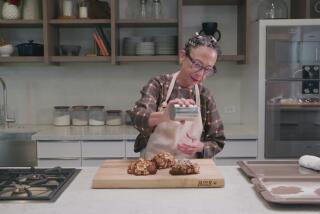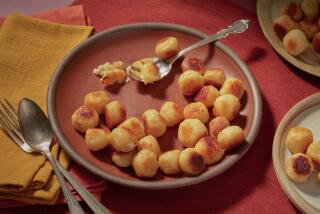BACK TO BASICS : Twice-Baked Spuds for Dad
- Share via
A friend of mine makes twice-baked potatoes by the dozens. She makes them, wraps them individually, freezes them, then pulls out just what she needs for a meal a week or a month later.
Certainly this make-ahead capability is a big plus, but another reason for the popularity of twice-baked potatoes is that they’re a terrific accompaniment to just about any type of meat, poultry or fish, especially those cooked on the outdoor grill. They’re a terrific side-dish, for instance, for a Father’s Day dinner.
Most general cookbooks include a recipe, but it may be listed as “stuffed” or “stuffed baked” potatoes.
Thick-skinned spuds, such as russets, are best for baking. Choose those that are evenly shaped, firm and free from large cuts, growth cracks and sprouting eyes. Avoid any with green-tinged skins.
If you want the shells piled high, baking an extra potato for every four you plan to fill ensures that there is an ample amount of mashed potatoes for stuffing.
Scrub the potatoes well under cold running water, then pat dry with paper towels. Pierce each in two or three places with the sharp tines of a fork to allow the steam to escape during baking. If desired, rub lightly with butter, margarine or vegetable shortening.
Bake the potatoes at 425 degrees for about an hour, until tender. Remove from the oven and slice horizontally, cutting off about a third of each potato (Step 1). With a spoon, scoop out the pulp (Step 2), leaving a thin shell; also remove the pulp from the smaller portions.
Milk, evaporated milk, half and half or whipping cream may be used when mashing the pulp. Whatever the choice, it should be heated; adding cold liquid cools the potatoes and tends to make them gummy.
The more liquid used, the creamier and thinner the end product. The amount needed can also depend on the variety of potatoes. Sour cream or yogurt may be substituted for part of the liquid, if desired. Softened butter or margarine, salt and pepper are other optional additions.
The pulp can be mashed, beaten with an electric mixer or pressed through a ricer.
To Mash: Use a potato masher, fork or wire whisk. Press the tool into the potato pulp in a downward motion, forcing the potatoes through the cutting grid. When almost fully mashed, gradually add milk (Step 3), beating with the masher, fork or wire whisk until light and fluffy.
To Beat: Begin by mashing the pulp slightly with the stationary beaters of an electric mixer. Turn the mixer on low speed and whip to the desired consistency, gradually adding milk.
To Rice: Place the pulp in the perforated cylinder of the ricer, then squeeze the long handles together to force the contents through the ricer holes. Let the rice-like pieces mound in a mixing bowl. Gradually add milk and beat with a fork, spoon or wire whisk until light and fluffy.
The mashed potatoes can either be spooned back into the shells or placed in a pastry bag with a decorative tip and piped (Step 4). At this point the potatoes may be wrapped and frozen for up to two months. To reheat, unwrap, place on a baking sheet and bake at 375 degrees about 45 minutes. Shredded cheese and chopped chives can be added about 10 minutes before the end of the baking time. If the potatoes are going to be used immediately, sprinkle with shredded cheese and chopped chives (Step 5) and bake at 425 degrees 20 to 25 minutes, until lightly browned and the cheese melts (Step 6).
Note : The smaller portions and extra skins can be recycled as appetizers. Freeze, then thaw and bake until crisp, sprinkling with shredded cheese a few minutes before serving. Garnish with guacamole and salsa.


